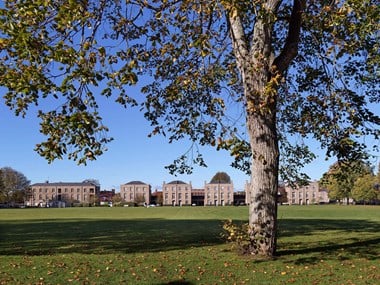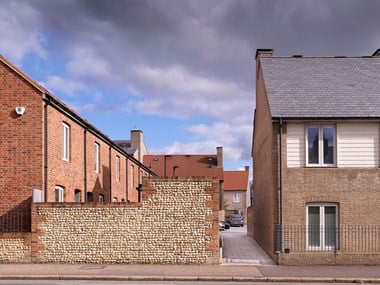Design Case Study: Roussillon Park Chichester, West Sussex
A new residential community within the historic boundary walls of a former military barracks.
This case study is one of ten studies of new residential or mixed-use developments compiled in 2020 by Purcell on behalf of Historic England.
Project information
- Region: South East
- Type of development: Former military site
- Location and postcode: Chichester, West Sussex, PO19 6BL
- Local planning authority: Chichester District Council
- Architects: Ben Pentreath
- Developer/landowner: ZeroC/Homes and Communities Agency
- No. of residential units: 252
- Site area: 6.5 hectares
Description of development
The site is located approximately one mile north of Chichester city centre. Following the departure of the Ministry of Defence in 2005, the site was acquired by the Homes and Communities Agency (now Homes England) for residential redevelopment. The open green space at the north end of the site and the perimeter boundary wall were retained, with new terraces, villas and apartment blocks configured into newly-formed streets in the otherwise cleared space. Further green spaces were created on the east and west sides of the site.
Heritage assets affected
The flint and brick boundary wall around the site is locally listed, as are two stones which were moved into the site from elsewhere – an obelisk which formerly demarcated the city boundary and a stone erected as a warning against smuggling. The site is located immediately adjacent to the Chichester and Graylingwell Conservation Areas. Although the site had been in military occupation since 1815, only one 1930s building of any note survived on the site prior to its development; a 19th-century keep survives outside the site boundary.
Planning context
Roussillon Barracks was long-listed as a potential residential development site in the Site Allocation: Preferred Approach Development Plan Document, following adoption of the Chichester Local Plan 2014-2029. A development brief with design standards was prepared by the Homes and Communities Agency (now Homes England) and the draft scheme was independently scrutinised by the South East Design Review Panel prior to seeking planning permission.
Assessment of design qualities and relationship to historic environment
The evolution of the scheme has been cognisant of the site’s strong military history and seeks to enhance this association despite very few surviving historical features. A 1930s neo-Georgian block was recognised as having some value but its poor construction-type and low energy efficiency meant it was incompatible with conversion. Consequently, the site was cleared of all buildings, although historic military buildings survive nearby on land still in MoD ownership.
The site is tightly contained within a high flint and brick wall on its east and west sides, which is a strongly characteristic feature of its former military use. Historically, this wall asserted a secure presence to prevent unwanted admission into the site and is a key feature within local streetscapes. In recognition of its importance, the wall has been retained but has had new openings created as part of the development scheme to encourage movement into the site. The re-instatement of gate piers that had been removed for military operations and security reasons now create a formal entrance into the site and assist in demarcating its spatial hierarchy.
The development is set out on a traditional grid of new streets and lanes, creating a hierarchical urban grain inspired by the primary/secondary/tertiary thoroughfares in Chichester’s city centre. The primary routes are arranged off the main entrance and around the Green. This is where the larger-scale buildings (three-storey townhouses and apartment blocks) are concentrated so that their presence balances with wide open space and they act as landmarks within the new townscape.
To emphasise the new permeability across the site, there are strategic gaps between the larger buildings along the periphery to facilitate views into the site from outside. The houses along the secondary and tertiary routes are of two storeys, scaled down to create more informal, mews-like streetscapes. To further emphasise the new development’s link with the city centre, minor adjustments were made to the masterplan layout in order to increase the visibility of the cathedral from the upper floors of a number of the new houses.
The architectural language of the new buildings is a contemporary take on the traditional buildings in the city centre, drawing influence from their scale, proportions and materials. Central Chichester has characteristically polite architecture; features such as tall casement windows, blind windows, parapet walls and restrained detailing are incorporated into the larger buildings at Roussillon Park. The smaller houses reflect a more vernacular domestic style, with smaller windows, clay peg tile roofs and flint detailing. The overall effect is simple with little extraneous ornamentation that has the potential to become dated.
Across all buildings, a high-quality specification has been adopted for the joinery, metalwork and rainwater goods. Natural materials were chosen for their ability to weather and age well, which is a key factor in designing within the historic environment. As such, no uPVC has been used. Windows are all painted timber and sit back within brick reveals, recreating the subtly modulated elevations typical of historic buildings but often omitted in new design or lost when windows are replaced. Likewise, all brickwork is laid in a Flemish bond using locally-characteristic red and soft grey bricks with header detailing for cills and other dressings, and rainwater goods are of cast metal. The use of a Flemish bond is especially notable as modern developments typically use a standard stretcher bond that does not match the quality of historic brickwork.
In the absence of any historic buildings surviving on the site, the developers have sought to incorporate the site’s heritage through the re-location of historic statuary from nearby locations, the reinstatement of a displaced commemorative plaque and choice of street names. By virtue of their simple and occasionally austere design, some pockets within Roussillon Park have recreated a barracks-like character.
Key points
In the absence of many strong historic landmark features, Roussillon Park has taken its principal architectural direction from Chichester city centre, whilst successfully retaining a characteristic boundary wall and green space. The strength of the architectural design comes from the quality of materials and detailing: using a characteristic local materials palette and respecting traditional traits such as brick bonds and other seemingly minor features which are frequently overlooked in new design.
Views of Rousillon Park
Please click on the gallery images to enlarge.
-
Design in the Historic Environment
Principles and case studies for good practice in design when making changes to the built historic environment.
-
Design in the Historic Environment: Case Studies
Download all ten case studies as a PDF document.
-
Wildernesse House Mews, Sevenoaks
Case study of a new mews-style development within the setting of a Grade II listed mansion and within an area of historic landscape.
-
Bourne Estate, Holborn, London
An award-winning residential extension on a Grade II listed urban estate, bringing together old and new through quality detailing and landscaping.
-
Design Case Study: 168 Upper Street, Islington
A case study of an imaginative reinstatement of a missing corner building in Islington that reproduces the original facade.
-
Temple Gardens, Temple Cloud
Design case study of the refurbishment and viable reuse of a listed pub, with a sensitive scheme of new housing and hotel development.
-
Fairmile Hospital
Case study of the re-development of a former hospital on the edge of a rural village with new homes designed as distinctive groups.
-
Garden Quarter, Caversfield
Case study for design in the historic environment of the sensitive redevelopment of a former Royal Air force site into a residential community.
-
Church Fields, Boston Spa
A design case study featuring a residential extension to the edge of an historic village that interprets traditional architectural forms.
-
Timekeepers Square, Salford
Case study of a redevelopment that recreates the vernacular Georgian terrace and urban grain within the setting of a listed church.
-
Welsh Streets Liverpool 8
Case study of an ambitious and popular scheme that converts hundreds of derelict Victorian terraced houses.












